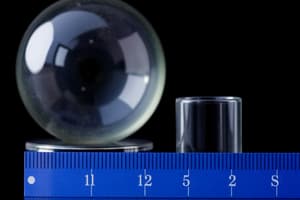Podcast
Questions and Answers
Which of the following is NOT a base quantity in the SI system?
Which of the following is NOT a base quantity in the SI system?
- Mass
- Time
- Energy (correct)
- Length
The unit for electric current is millivolt.
The unit for electric current is millivolt.
False (B)
What prefix is used in the SI system to denote one thousandth (1/1000)?
What prefix is used in the SI system to denote one thousandth (1/1000)?
milli
One mole contains _____ particles, known as Avogadro's constant.
One mole contains _____ particles, known as Avogadro's constant.
Match the following base quantities with their SI units:
Match the following base quantities with their SI units:
Which of the following is a derived quantity?
Which of the following is a derived quantity?
Waves transfer both energy and matter.
Waves transfer both energy and matter.
What is the unit symbol for the SI unit of thermodynamic temperature?
What is the unit symbol for the SI unit of thermodynamic temperature?
What is the prefix that corresponds to the factor of $10^6$?
What is the prefix that corresponds to the factor of $10^6$?
A digital micrometer screw gauge can measure lengths up to 10 centimeters.
A digital micrometer screw gauge can measure lengths up to 10 centimeters.
What is the SI unit for length?
What is the SI unit for length?
The smallest unit an instrument can measure is known as its __________.
The smallest unit an instrument can measure is known as its __________.
Match the following measuring instruments with their range:
Match the following measuring instruments with their range:
Which of the following is an example of a scalar quantity?
Which of the following is an example of a scalar quantity?
Parallax errors are a type of measurement error that occurs when the measurement is not taken straight on.
Parallax errors are a type of measurement error that occurs when the measurement is not taken straight on.
What device is considered the most accurate timekeeping device?
What device is considered the most accurate timekeeping device?
Which of the following is a vector quantity?
Which of the following is a vector quantity?
Speed is a scalar quantity.
Speed is a scalar quantity.
What is the SI unit of mass?
What is the SI unit of mass?
The prefix 'kilo-' denotes a factor of ______.
The prefix 'kilo-' denotes a factor of ______.
Match the instrument to its appropriate use:
Match the instrument to its appropriate use:
What is the approximate result of a car moving 90 km/h due east for one hour and then 60 km/h due west for one hour?
What is the approximate result of a car moving 90 km/h due east for one hour and then 60 km/h due west for one hour?
Accurate measurement tools such as digital calipers can provide readings with greater precision than a metre rule.
Accurate measurement tools such as digital calipers can provide readings with greater precision than a metre rule.
What is Avogadro's constant?
What is Avogadro's constant?
Flashcards
Physics
Physics
The study of the natural world, from the very small to the very large.
Physical Quantities
Physical Quantities
Quantities that can be measured, including a numerical value and a unit.
SI Units
SI Units
A system of standardized units for measurements, like the meter, kilogram, and second.
Base Quantities
Base Quantities
Signup and view all the flashcards
SI Unit for Length
SI Unit for Length
Signup and view all the flashcards
SI Unit for Mass
SI Unit for Mass
Signup and view all the flashcards
SI Unit for Time
SI Unit for Time
Signup and view all the flashcards
Derived Quantities
Derived Quantities
Signup and view all the flashcards
Scalar Quantity
Scalar Quantity
Signup and view all the flashcards
Vector Quantity
Vector Quantity
Signup and view all the flashcards
Distance
Distance
Signup and view all the flashcards
Displacement
Displacement
Signup and view all the flashcards
Speed
Speed
Signup and view all the flashcards
Velocity
Velocity
Signup and view all the flashcards
Graphical Method (Vectors)
Graphical Method (Vectors)
Signup and view all the flashcards
Prefixes
Prefixes
Signup and view all the flashcards
Tera (T)
Tera (T)
Signup and view all the flashcards
Micro (µ)
Micro (µ)
Signup and view all the flashcards
What is the smallest unit an instrument can measure?
What is the smallest unit an instrument can measure?
Signup and view all the flashcards
Parallax Error
Parallax Error
Signup and view all the flashcards
Zero Error
Zero Error
Signup and view all the flashcards
What is a vector quantity?
What is a vector quantity?
Signup and view all the flashcards
What is a scalar quantity?
What is a scalar quantity?
Signup and view all the flashcards
Study Notes
Physical Quantities, Units, and Measurements
- Measurements are crucial in daily life, especially during pandemics.
- Body temperature measurement helps prevent disease spread.
- A physical quantity consists of a numerical magnitude and a unit.
- Examples of base quantities (SI units) include mass (kg), length (m), and time (s).
- Other base quantities are electric current (A), thermodynamic temperature (K), amount of substance (mol).
- Prefixes (e.g., nano, micro, milli, centi, kilo, mega, giga, tera) are used for submultiples and multiples of SI units.
What is Physics?
- Physics studies the natural world, from the very large (e.g., solar system) to the very small (e.g., atom).
- Two key concepts are matter and energy.
- Disciplinary ideas in physics explain real-life phenomena: Matter and energy make up the Universe; Matter interacts through forces and fields; Forces help us understand motion; Waves transfer energy without transferring matter; Conservation laws constrain changes in systems; Microscopic models explain macroscopic phenomena
What are Physical Quantities?
- Physical quantities are measurable quantities with magnitude and units.
- Seven basic physical quantities are used for measurements.
- The International System of Units (SI) ensures standardized measurements.
- Standard form and prefixes are useful for representing extremely large or small values.
How do we Measure Physical Quantities?
- Appropriate instruments are essential foraccurate measurements.
- Examples include metre rules, measuring tapes, digital calipers, and digital micrometer screw gauges.
- Precision of an instrument refers to its smallest measurable unit.
What are Scalars and Vectors?
- Scalar quantities have only magnitude (e.g., distance, speed, mass).
- Vector quantities have both magnitude and direction (e.g., displacement, velocity, force).
- Vectors can be added graphically (head-to-tail method).
- Distance and displacement are related but distinct concepts.
- Speed and velocity are related but distinct concepts.
Studying That Suits You
Use AI to generate personalized quizzes and flashcards to suit your learning preferences.




